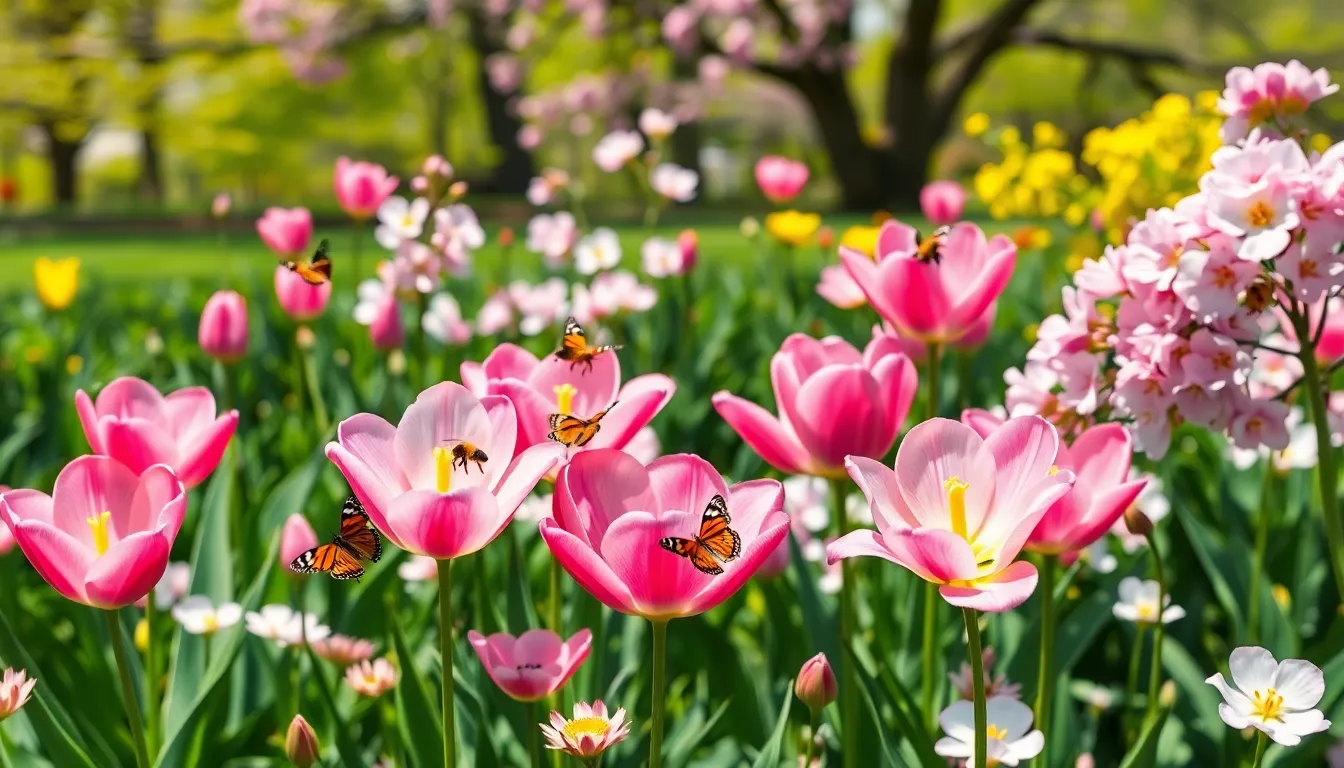As winter reluctantly hands over the reins, spring bursts onto the scene like a kid at a birthday party, ready to steal the show. Nature’s grand revival is nothing short of a spectacular performance, with flowers blooming and trees donning their fresh green attire. It’s the season where everything comes alive, and even the grumpiest of folks can’t help but smile at the sight of daffodils swaying in the breeze.
Nature Spring Season
Spring brings a spectacular display of colors in nature. Flowers such as tulips, daffodils, and cherry blossoms bloom, painting landscapes with vibrant shades. New leaves unfurl on trees, creating a lush canopy that provides shade and shelter.
Wildlife becomes more active during this season. Birds return from migration, filling the air with their melodious songs. Insects, such as butterflies and bees, emerge to pollinate flowers, playing a crucial role in ecosystems.
Rainfall during spring nourishes the soil, promoting growth. Gardens flourish with vegetables and flowers, attracting gardeners and nature enthusiasts alike. Parks and natural reserves fill with visitors eager to witness the awakening of fauna and flora.
The warming temperatures encourage outdoor activities. People enjoy hiking, picnicking, and leisurely walks, immersing themselves in the beauty surrounding them. Families often make memories in blooming gardens and blossoming trees, creating a welcoming atmosphere for all.
In essence, spring captivates with its lively transformation. Nature showcases its artistic side, inspiring appreciation for diverse ecosystems. Visitors marvel at the radiant colors and sounds, a stark contrast to winter’s dormancy. The season symbolizes renewal, reminding everyone of the beauty found in natural cycles.
The Science Behind Spring

Spring emerges with rising temperatures and increased sunlight, triggering various biological processes. These factors greatly influence natural ecosystems and drive seasonal changes.
The Role of Temperature and Sunlight
Temperature and sunlight play critical roles in the transition to spring. Warming air temperatures stimulate the germination of seeds, resulting in vibrant flower blooms and lush green foliage. Sunlight duration increases significantly, promoting photosynthesis and energy production in plants. This energy fuels growth and brings brightness to landscapes. Warmer conditions also regulate animal behavior, encouraging migration, reproduction, and foraging among wildlife.
Seasonal Changes in Flora and Fauna
Flora and fauna undergo significant transformations in spring. Flowering plants like tulips and cherry blossoms bloom, attracting pollinators such as bees and butterflies. Insects emerge from winter dormancy, enhancing pollination and ecosystem balance. Animals become more active, with birds returning to nest and mammals engaging in mating behaviors. These interactions create a dynamic ecosystem, showcasing nature’s recovery from winter dormancy.
Activities to Enjoy During Spring
Spring invites a range of activities that celebrate the season’s beauty. Embracing the outdoors enriches the experience of renewal.
Hiking and Exploring Nature Trails
Hiking offers a unique way to connect with nature. Trails across parks provide stunning views as flowers bloom and wildlife re-emerges. Visitors often encounter vibrant wildflowers and the songs of returning birds. With fresh air and warmer temperatures, walking in nature rejuvenates both body and spirit. Local trails featuring varying difficulty levels cater to all ages and fitness levels. Exploring scenic routes can lead to breathtaking vistas, making each hike an adventure. Planning outings with friends and family enhances shared experiences, allowing for memorable moments in the great outdoors.
Gardening Tips for Spring Planting
Gardening becomes a rewarding spring activity for all enthusiasts. Preparing soil early ensures a healthy environment for planting. Selecting native plants enhances the local ecosystem while attracting wildlife. When choosing seeds, consider fast-growing varieties for quicker blooms and produce. Regular watering and monitoring for pests promotes vigorous plant growth. Setting up a compost bin can enrich soil quality and minimize waste. Utilizing raised beds offers clear organization and accessibility for gardeners. Spring unfolds a canvas for creativity and nourishment, rewarding gardeners with fresh blooms and homegrown vegetables.
The Importance of Spring in Ecosystems
Spring plays a crucial role in revitalizing ecosystems. Warmer temperatures stimulate seed germination, leading to the emergence of various plant species. Longer daylight hours significantly enhance photosynthesis, fueling robust plant growth. This revitalization attracts diverse wildlife, increasing animal activity. Birds return from migration, seeking food and nesting sites, while insects emerge to pollinate blooming flowers.
A healthy spring environment fosters biodiversity. Vibrant blooms from flowers like tulips, daffodils, and cherry blossoms create habitats for pollinators. Numerous species rely on these plants for sustenance during their critical life cycles. Additionally, as flora flourishes, they support herbivores, leading to increased predator activity within the ecosystem.
Rainfall during spring replenishes water sources, allowing plants to absorb vital nutrients. Adequate hydration encourages resilience against pests and diseases. Flourishing gardens and parks invite gardeners and those seeking connection with nature. Outdoor spaces thrive as a result of this season’s nourishing conditions.
Promoting interactions among species forms dynamic relationships essential for ecosystem health. Plants offer food and shelter, while animals contribute to seed dispersal and pollination. This cooperative network strengthens food chains, enhances habitat quality, and maintains ecological balance.
Spring’s transition from dormancy introduces fresh life, cascading through ecosystems. The interplay of rising temperatures, increased sunlight, and active wildlife showcases nature’s resilience and interconnectedness. As these processes unfold, spring unveils a vibrant tapestry of life that enriches ecosystems and nurtures appreciation for the natural world.
Conclusion
Spring represents a time of renewal and vibrant transformation in nature. As the world awakens from winter’s slumber, it invites everyone to engage with the beauty surrounding them. The lively colors and sounds of the season inspire joy and a sense of connection to the environment.
Embracing outdoor activities like hiking and gardening not only enhances appreciation for nature but also fosters a deeper understanding of the ecosystems at play. With each bloom and chirp, spring reminds us of the resilience of life and the intricate relationships that sustain it. This season encourages exploration and celebration of the natural world, making it a cherished time for all.

